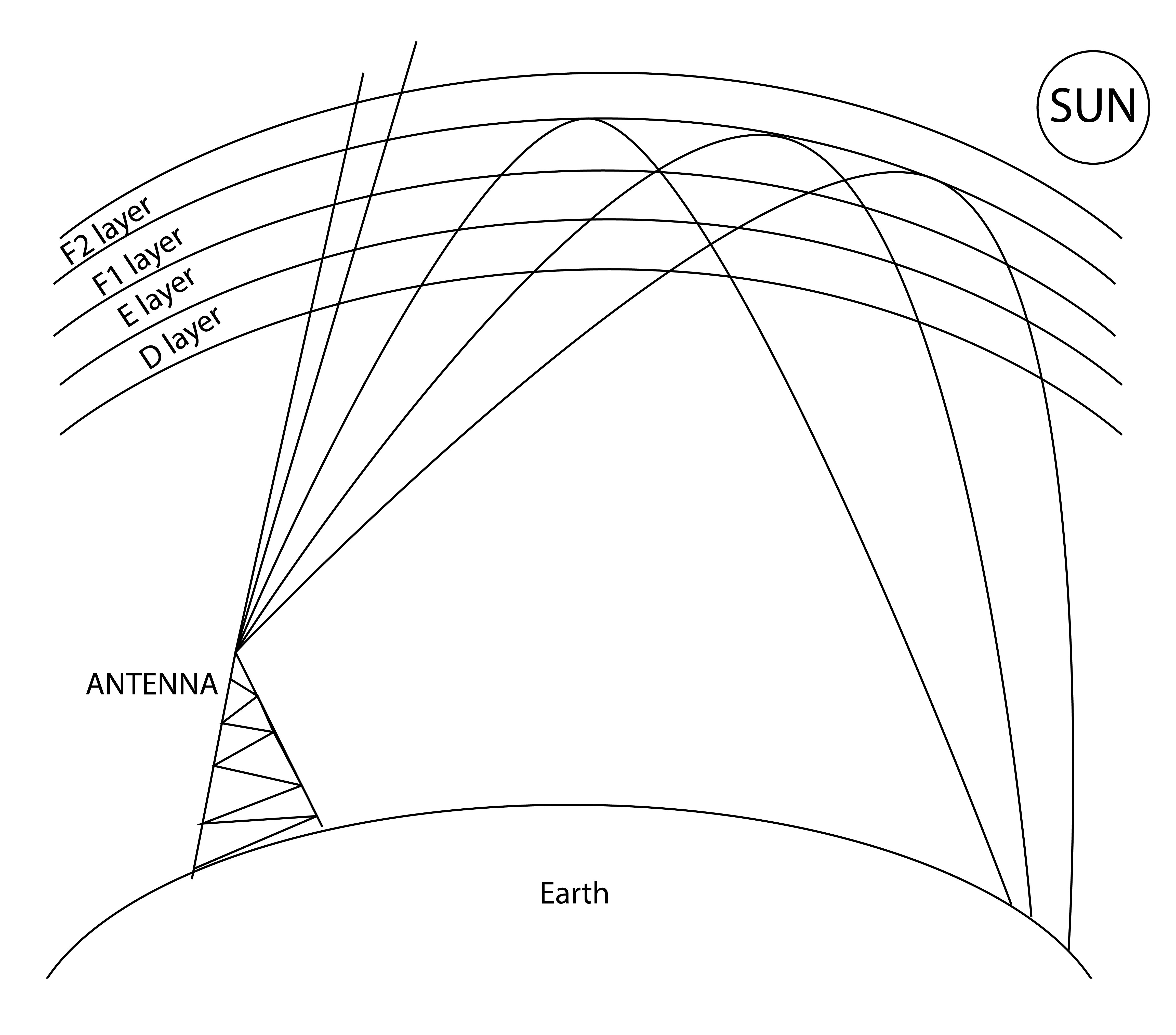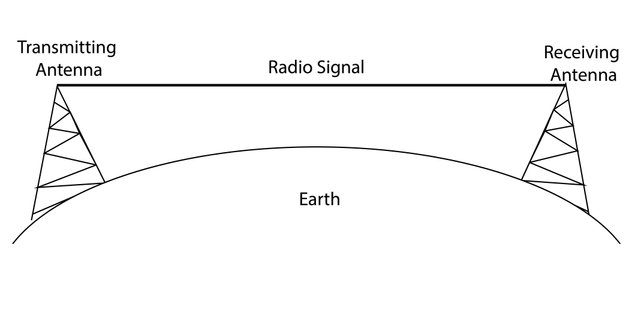RADIO SIGNALS & IT'S MODE OF PROPAGATION

INTRODUCTION
So last week, my niece came to visit. She had this assignment, her teacher had given them a task as to how Radio waves were propagated. She came to me with the assignment, I put her through, and then I decided to share the article with SteemIt.
RADIO WAVE & IT’S PROPAGATION
Radio waves is a type of electromagnetic radiation. It has wavelengths longer than that of the infrared light. Radio waves have frequencies between 3kHz to 300GHz. And as usual, since it is an EM wave, it travels with the speed of light.
Radio waves which were originally called “Hertizian waves” was first predicted by the Scottish mathematical physicist James Clerk Maxwell. Guglielmo Macroni developed the first practical radio transmitters and receivers.
Radio waves can be generated naturally or artificially. Natural generated waves are caused by lightning, or by astronomical objects. Artificial generated radio waves are produced by transmitters, these artificial ones are used for radio communication, broadcasting, radar and other navigation systems. And these are the ones in which we would look at their mode of propagation.
MODE OF RADIO WAVE PROPAGATION
Once a radio signal has been radiated by the antenna, it will propagate through space and will in the end, redach the receiving antenna. As expected, the energy of the signal decreases as the distance between the transmitter and the receiver is increased further. Radio signals can take one or more of several different paths to the receiving antenna. The path in which the radio signal takes depends a lot on some factors such as frequency of the signal, atmospheric conditions and time of the day. There are three basic paths which a radio signal can take through space.
- Ground or surface wave
- Sky wave or ionospheric wave
- Space or direct waves
Ground or Surface wave:
The ground of surface waves leaves the transmitter and remains close to the earth. The ground waves will actually follow the curvature of the earth and can there travel at distances beyond the horizon. Ground wave propagation is strongest at Low and Medium Frequency ranges. This means that ground waves are main signal path for radio signals in the 30kHz to 3Mhz range. The signals can travel for hundreds and/or thousands of metres at these low frequencies. Amplitude modulation broadcast signals are propagated primarily by ground waves.

However, ground wave propagation cannot be used for the propagation of signals above 3MHz because at frequencies above 3Mhz, the earth begins to attenuate (lower) the radio signals. Objects on the earth and terrain features become the same order of magnitude in size as the wavelength of the signal and will therefore absorb the signals, thereby attenuating the signals.
The Sky Wave or Ionospheric Wave:
A sky wave is the one that is radiated by the antenna into the upper atmosphere where it is bent or reflected back to the earth. This bending of the signal is caused by a region in the upper atmosphere known as the ionosphere, hence the sky wave can also be called Ionospheric waves. The ionosphere is a region that absorbs large quantities of radiant energy from the sun and thus it become sheated and ionized (electrically charged). Important ionizing agents in the ionosphere are ultraviolet and α,β,ϒ radiation from the sun as well as cosmic rays. The ionosphere is divided into three basic layers, D layer, E layer and the F layer.
The D and E layers are weakly ionized areas because they are far from the sun. The degree of its ionization depends on the altitude of the sun above the horizon and thus it disappears at night. The reason for the dissapperance is the recombination of ions into molecules. This happens because of the absence of sun (at night). The main effects of the D and E layers is the reflection of waves of very low frequency and low frequency from the ionosphered. The D and E layers also absorbs medium frequency waves.
The F layer is considered to be divided into two sub layers, known as F1 and F2. These sub layers are highly ionized since they are closest to the sun. This means that the F layer have most effects on radio signals. The F layer exists both during the day and the night. The effect of the F layer is to cause refraction of the radio signal (high frequency signals). Refraction simply means the deflection of electromagnetic waves such as radio waves, light or even sound waves when the waves crosses a boundary line between two media with different characteristics. In the case of the ionosphere, which we are concerned with, the boundary is the interface between different levels of ionization. When the radio signal goes into the ionosphere, the different levels of ionization will cause the radio signal to be gradually bent. The direction of bending depends upon the angle at which the radio wave enters the ionosphere and the different degrees of ionization of the layers. If the angle of entry is small, the radio signal will be bent and sent back to earth, this would appear as if the radio signal was reflected by the ionosphere, but in reality, the ionosphere actually refracted the radio signal.

Direct or Space wave propagation:
A direct wave is the one that travels in a straight line directly from the transmitting antenna to the receiving antenna. Direct wave radio signaling is referred to as line of sight communications. Line of sight communications by direct wave nis characteristics of most radio signals with a frequency above 30MHz that is VHF, UHF and microwave signals. Direct waves are not refracted, neither do they follow the curvature of the earth. Direct wave have a straight line nature and because of this, they will be blocked at one point because of the curvature of the earth. The signals travel horizontally from the antenna until they reach the horizon at which point they are blocked.

If the signal is to be received beyond the horizon, then the antenna must be high enough to intercept the straight-line radio waves. However, to extend the communication distance at microwave frequencies, special techniques are adopted. The most important of these techniques is the use of repeater stations. A repeater is basically a combination of a receiver and a transmitter. The function of a repeater is to pick up the radio signal from a transmitter, amplify it and transmit it on another frequency to the receiver. A whole string of repeater stations can relay signals for long distances.
**Image Source: **
All images used in this writeup were designed by me.
References:
- Principles of Telecommunications by Late P. Otasowie, 1st edition
- https://en.m.wikipedia.org/wiki/Radio_wave
@okipeter , you have a beautiful post here. But you have some correction to make. Well I can see you now on the steemSTEM discord server. So it will be okay. I was about giving you a invite link.
Just give me some feedback
This is a subject I should know a lot more about than I do as my father worked with microwave links. Much of the communication along the east coast of Australia was done via Microwave links on mountain tops, I'm not sure whether that has been superseded by fibre-optics now.
Any way good job on the post and the diagrams btw! I also dropped a noted to your mentor as well as there is one or two minor corrections.
No prob. Thanks for the feedback